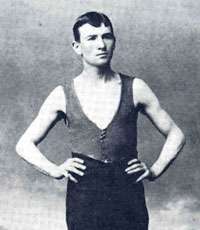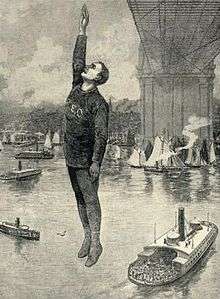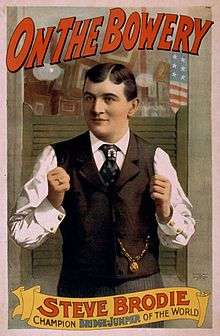Steve Brodie (bridge jumper)
Steve Brodie (December 25, 1861 – January 31, 1901) was an American from Manhattan, New York City, who on July 23, 1886, claimed to have jumped off the Brooklyn Bridge and survived. The supposed jump, of which the veracity was disputed, gave Brodie publicity, a thriving saloon and a career as a performer.
Steve Brodie | |
|---|---|
 Steve Brodie circa 1885 | |
| Born | December 25, 1861 Manhattan, New York City, U.S. |
| Died | January 31, 1901 (aged 39) San Antonio, Texas, U.S. |
| Occupation | Actor |
Brodie's fame persisted long past his death, with Brodie portrayed in films and with the slang term "Brodie"—as in to "do a Brodie"—entering American vernacular, meaning to take a chance or a leap, specifically a suicidal one.[1]
Alleged bridge jump

The bridge, then known as the East River Bridge, had opened just three years before Brodie's claimed jump. A swimming instructor from Washington, D.C. named Robert Emmet Odlum, the brother of women's rights activist Charlotte Odlum Smith, was killed while attempting the same stunt in May 1885.[2]
The jump supposedly made by Brodie on July 23, 1886, was from a height of 135 feet (41 m), the same as a 14-storey building.[3] The contemporary New York Times account said the jump was from a height of about 120 feet (37 m).[2]
The New York Times backed his account of the jump and said that Brodie practiced for the leap by making shorter jumps from other bridges and ships' masts, and that it was witnessed by two reporters. He leaped into the East River, feet first, and emerged uninjured, though with pain on his right side. He was jailed after the jump. The Times described Brodie as a "newsboy and long-distance pedestrian" who jumped from the bridge to win a $200 bet, equal to $5,700 today. In other accounts he is described as a bookmaker and gambler.[2][3]
A Bowery storekeeper named Isaac Meyers claimed that he encouraged Brodie to jump off the Brooklyn bridge after Brodie said that he wanted to be famous.[4]

Another account holds that Moritz Herzber, a liquor dealer, offered to back a saloon for Brodie if he made the jump and lived.[3]
If true, he would have been the first person to have jumped off the bridge and survived,[2] but his claim was disputed. It was subsequently claimed that a dummy was thrown from the bridge and that Brodie fell out of a row boat.[5]
After the jump, Brodie opened a saloon at 114 Bowery near Grand Street, which also became a museum for his bridge-jumping stunt. Among the decorations was an affidavit from the boat captain who claimed to have pulled him from the water. He became an actor capitalizing on his reputation, appearing in the vaudeville musicals Mad Money and On the Bowery, and opened a saloon in Buffalo, New York.[3]
Brodie died in San Antonio, Texas, in 1901. The cause of death has been variously described as diabetes and tuberculosis.[3][6]
Controversy
Doubt whether Brodie actually made the claimed jump arose immediately and has lingered to this day.
Brodie, who was unemployed and aware of the publicity generated by Odlum's fatal jump, bragged to his pals on the Bowery that he would take the jump. Wagers were made for and against, but Brodie never announced when he would make the attempt.[7] The Brooklyn Eagle reported in 1930 that a retired police sergeant and friend of Brodie, Thomas K. Hastings, said that Brodie had told him that he didn't make the leap and never said he did.
In his book The Great Bridge, historian David McCullough said that he probably did not make the jump. McCullough said that it was commonly believed by skeptics that a dummy was dropped from the bridge, and that Brodie merely swam out from shore and surfaced beside a passing barge.[7]
The NYPD said in 1986, the 100th anniversary of the supposed jump, that two or three people jump from the bridge every year and some live.[7] Only one month after Brodie's jump, Larry Donovan jumped from an even higher point of the bridge, making him the first confirmed survivor of a Brooklyn Bridge leap.
In popular culture

Brodie became a popular symbol of the Bowery and appeared personally in musical shows, and his character was used many times in film depictions of old New York. He starred in a three-act play titled On the Bowery by Robert Neilson Stephens, which opened in 1894. A facsimile of Brodie's saloon was the setting for the second act, and Brodie sang a song, "My Poil is a Bowery Goil". Valerie Bergere played Blanche Livingstone, the girl he rescues and then falls in love with. The play culminated with Brodie jumping off the bridge.[8][9]
George Raft portrayed Brodie in the 1933 movie The Bowery which presents a fictional account of Brodie's dive. Years later, an actor named John Stevenson used Brodie's name for his movie stage name.[10] In the 1946 noir film The Dark Corner (starring Lucille Ball and Mark Stevens), a Taxi Driver, when asked about William Bendix's gangster character falling to his death, said he "[n]ever saw anyone ever pull a Brodie and bounce."
In 1949, Warner Brothers released the Merrie Melodies cartoon Bowery Bugs, in which Bugs Bunny tells an old man the story of the Steve Brodie jump (in typical Looney Tunes fashion, of course; in the episode Brodie's name is spelled "BRODY" on a plaque on the bridge in the spot where "Brody" supposedly jumped from). It's never mentioned in the cartoon whether or not Bugs was trying to sell the old man the Brooklyn Bridge or simply the story of "Brody's" jump. At the end, Bugs says to the old man, "And that's why Steve Brody jumped off the Brooklyn Bridge. Anything more you want to know?" and the old man replies, "Nope. That's enough, son. I'll buy it". Bugs then breaks the fourth wall with a wink as the old man starts counting money into Bugs's hand.
The disastrous 1965 Broadway musical Kelly (musical) was inspired by Brodie and climaxes with the lead character Hop Kelly completing the dive.
The phrase "taken a Brody" is used in Thomas Pynchon's 1963 novel V.: "And next day she would read in the paper where Esther Harvitz, twenty-two, honors graduate of CCNY, had taken a Brody off some bridge, overpass or high building."[11] Pynchon also used in The Crying of Lot 49: "...my best guide to the Trystero has taken a Brody." [12] It also appears in David Foster Wallace's 1996 novel Infinite Jest: "McDade bitched at the meeting that if he had to watch Nightmare on Elm Street XXII: The Senescence one more time he was going to take a brody off the House's roof."[13]
References
- Freeman, Morton S. (May 1, 1997). A new dictionary of eponyms. Oxford University Press US. pp. 33–. ISBN 978-0-19-509354-4. Retrieved April 25, 2011.
- "A Leap From the Bridge" (PDF). The New York Times. July 24, 1886. Retrieved 29 October 2010.
- Williams, Jasmin K. (Nov 5, 2007). "Steve Brodie — Daredevil Or Hoaxter?". New York Post. Retrieved April 24, 2011.
- Associated Press (June 20, 1948). "Isaac Meyers Dies; Says He Told Brodie to Jump". Youngstown Vindicator. Retrieved April 24, 2011.
- "Steve Brodie's Career Ended". Baltimore American. February 1, 1901. Retrieved October 29, 2010.
- ""Steve" Brodie's Funeral" (PDF). The New York Times. Feb 7, 1901. Retrieved 29 October 2010.
- Larry McShane (July 24, 1986). "Did Saloon Owner Actually 'Pull a Brodie'?". The Day. Associated Press. Retrieved 25 April 2011.
- Batterberry, Michael; Batterberry, Ariane Ruskin (1999). On the town in New York: the landmark history of eating, drinking, and entertainments from the American Revolution to the food revolution. Psychology Press. pp. 150–. ISBN 978-0-415-92020-9. Retrieved 24 April 2011.
- On the Bowery, Internet Broadway Database Retrieved December 27, 2013
- Soden, Garrett (2005). Defying Gravity: Land Divers, Roller Coasters, Gravity Bums, and the Human Obsession With Falling, New York: W. W. Norton & Company; ISBN 0-393-32656-X
- Pynchon, Thomas. V. Harper, New York, 2005, p. 135
- Pynchon, Thomas (1966). The Crying of Lot 49. New York: Bantam. p. 114. ISBN 9780553120653.
- Wallace, David Foster (1996). Infinite Jest. New York: Little, Brown. p. 825. ISBN 0-316-92004-5.